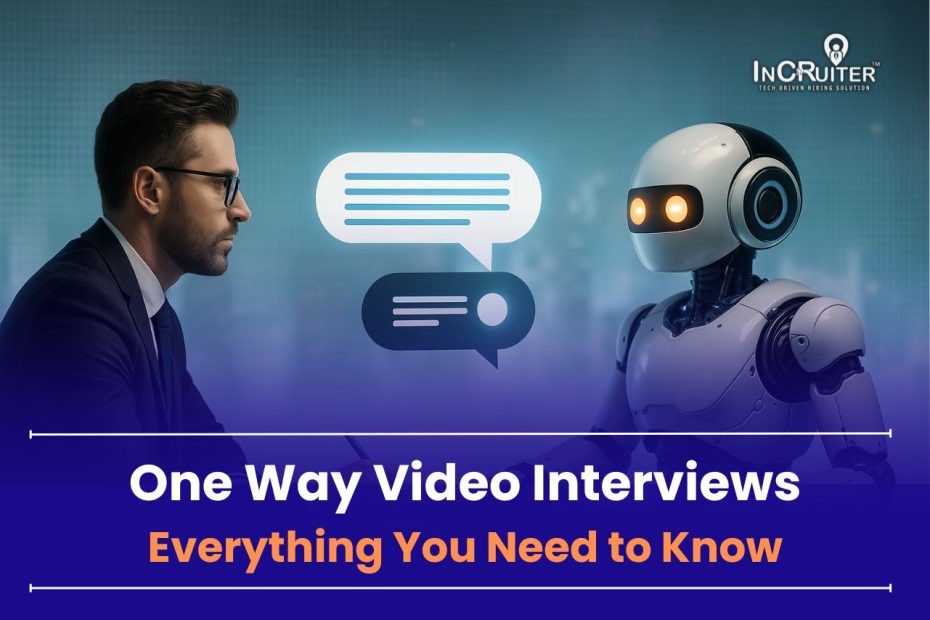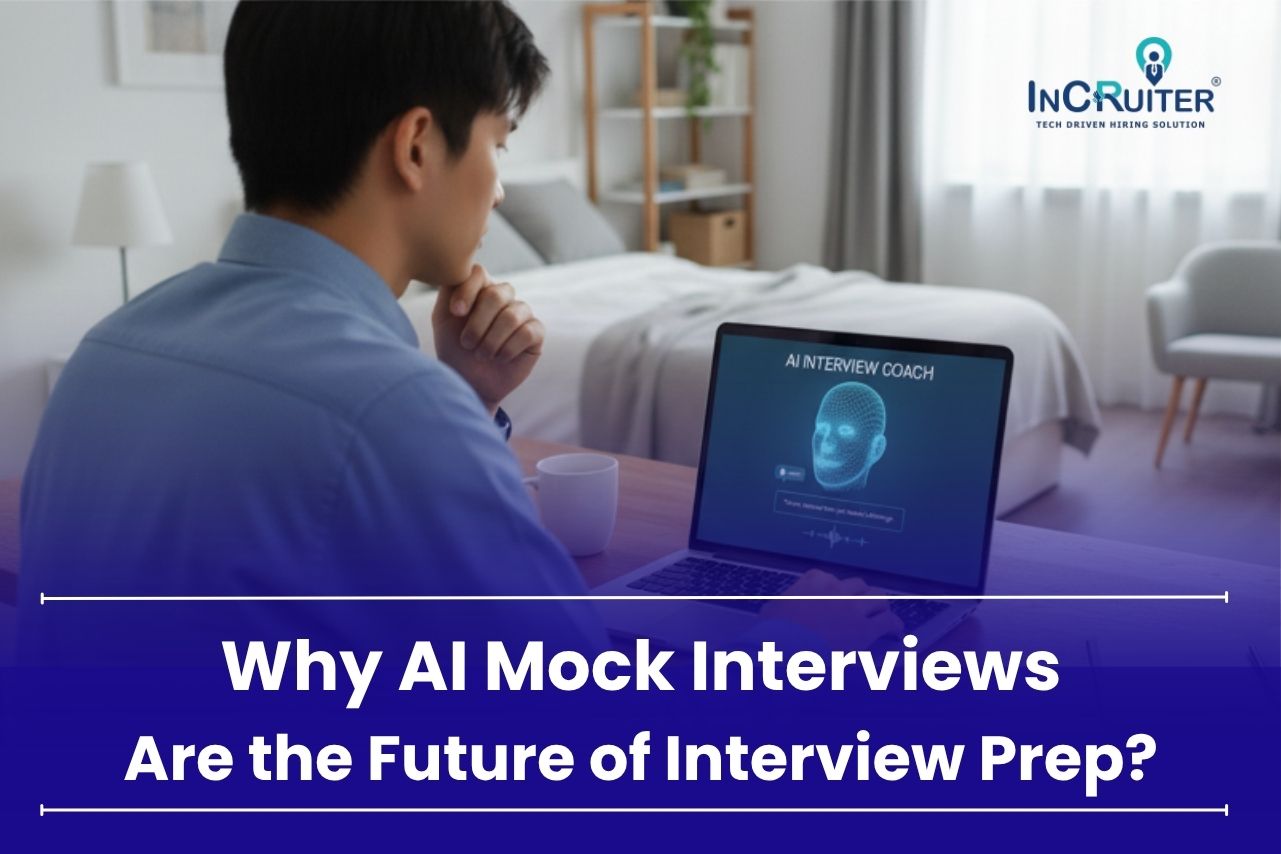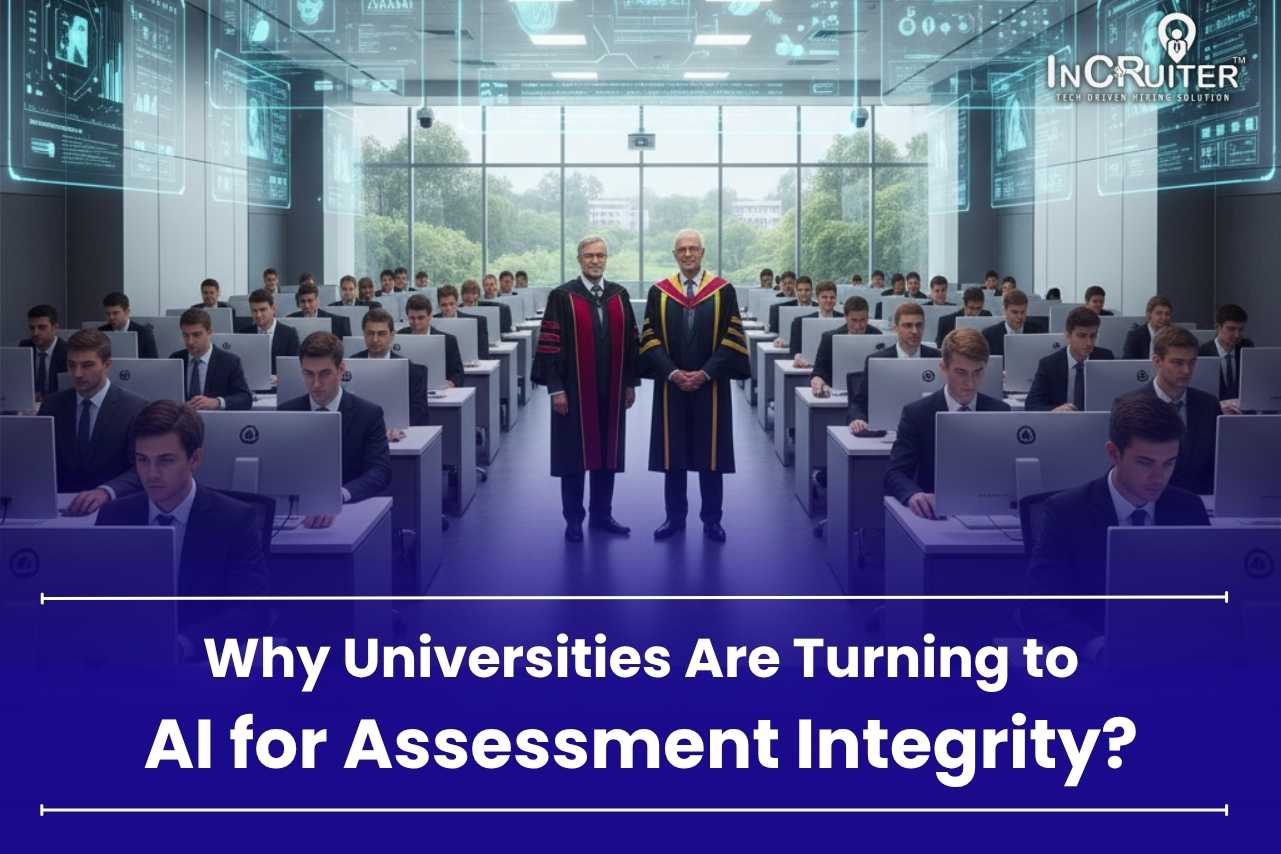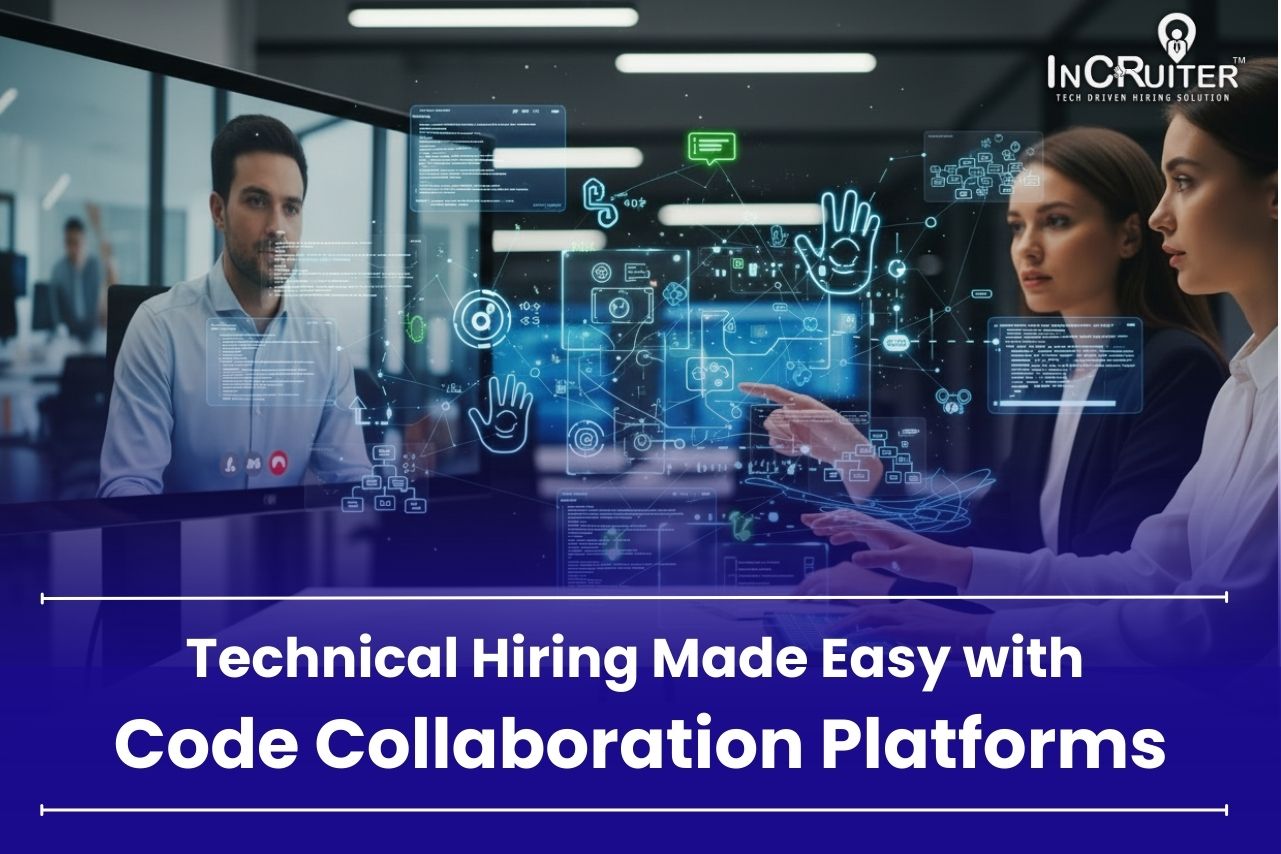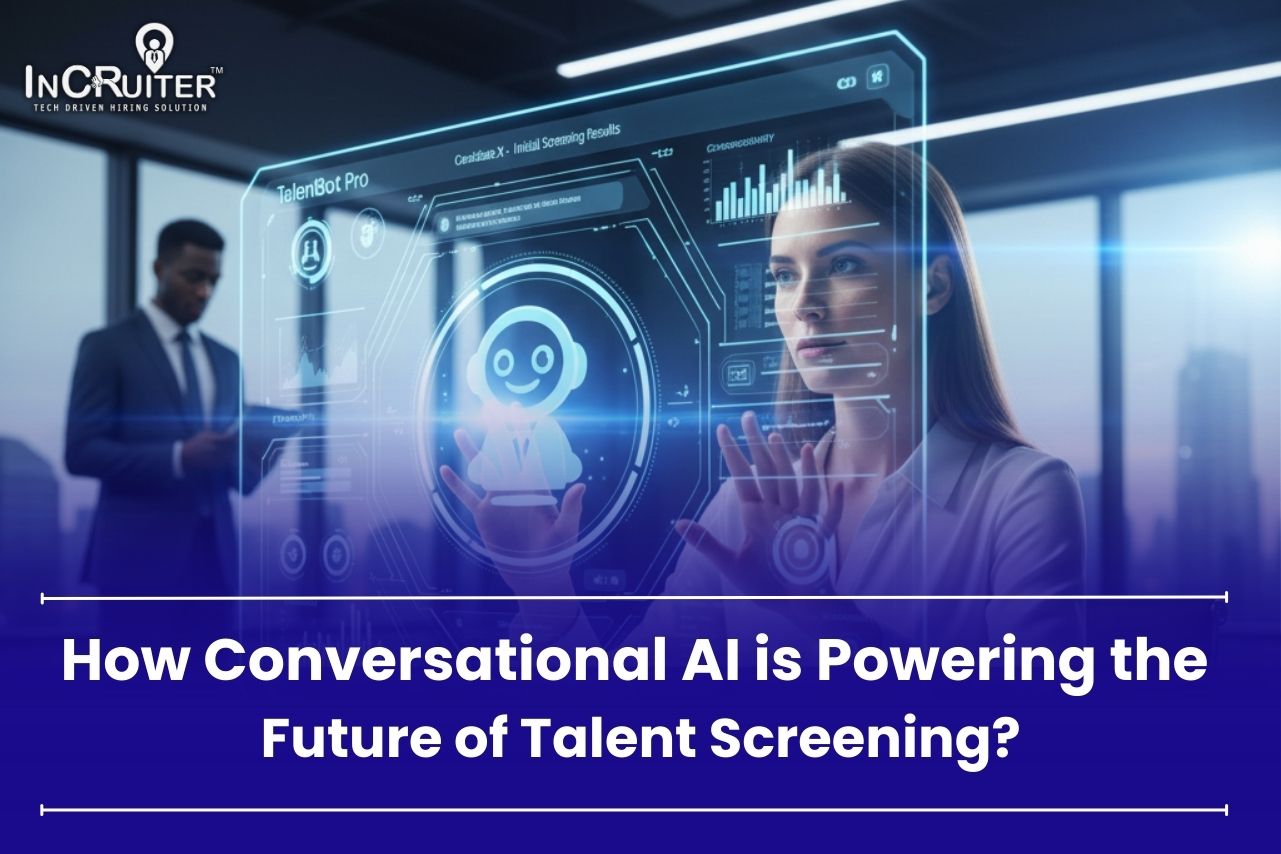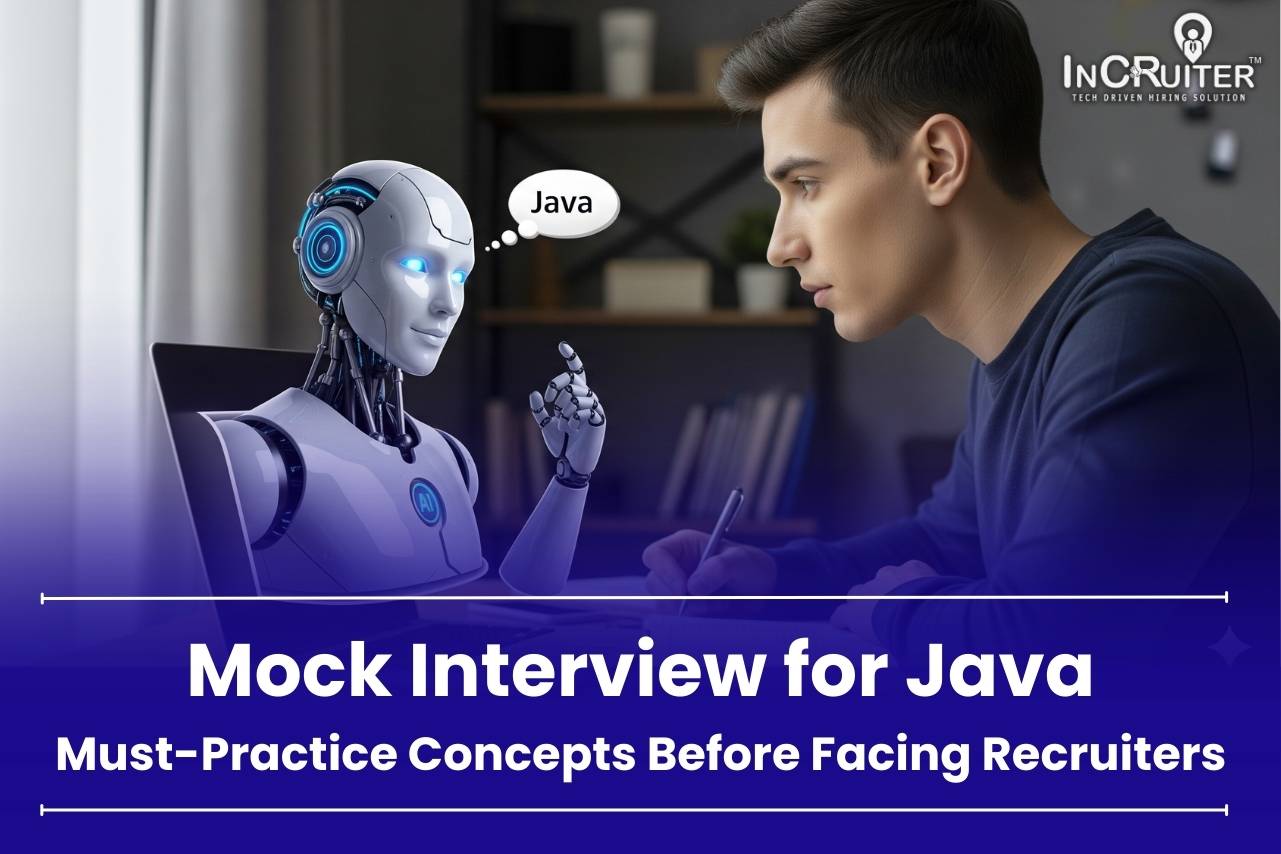A failed hiring process is like trying to fill a bucket with a hole at the bottom. No matter how many resumes you pour in, the right talent seems to slip away. The traditional recruitment system, filled with endless phone screens, scheduling back-and-forths, and subjective assessments, has become a drag on efficiency and a real bottleneck in finding the right fit. The landscape is shifting fast. Companies face rising volumes of applications, growing pressure to speed up hiring, and the need to deliver fair, unbiased assessments. This is where one-way video interviews are stepping in.
Unlike conventional methods, they offer an asynchronous approach powered by AI. Candidates respond to pre-set questions independently without a human interviewer present. The technology allows recruiters to break free from calendar constraints and focus on evaluating what truly matters.
In this blog, we will explore how one-way video interviews are reshaping hiring, making it faster, fairer, and smarter.
What is a One-Way Video Interview?
A one-way video interview is a preliminary evaluation method in which individuals record responses to a standardized set of predefined questions using an AI video interview software. This process occurs without real-time interaction between the respondent and the evaluator.
It is commonly employed during the initial stages of recruitment to assess qualifications, communication skills, and suitability for a role before advancing individuals to subsequent phases of the selection process. This format promotes consistency, scalability, and flexibility in early-stage hiring evaluations.
How One-Way Video Interviews Work?
A one-way video interview runs entirely through automation. Responses are recorded and evaluated by the AI system without any need for manual review. Based on predefined scoring criteria, the system ranks all responses and provides a ready list of top performers. This helps the hiring team focus only on the most suitable profiles, saving time and ensuring fair and consistent evaluation across all participants.
1. Create the Position
- Define Job Title and Requirements: The User begins by specifying the job title, domain, experience range, and number of positions. This sets clear expectations.
- Customize or Auto-Generate Job Description: They can upload a custom job description or use the AI-generated option to craft one that is aligned with the role.
- Set Mandatory and Optional Skills: At least two required skills are specified to ensure the applicant meets core requirements, with optional skills added for deeper filtering.
- Finalize Position Setup: Once all fields are complete, recruiters click “Create Position” to activate the role and start the interview workflow.
2. Set Up One-way Interview
- Select Position and Interview Type: The User selects the relevant position and label for the interview and also chooses the interview type, such as conversational, to match the job’s communication needs.
- Organize Questions by Sections: They set up interview sections like general, role-specific, coding, and aptitude questions. Each section can include a specific number of questions and duration, aligning with the evaluation focus.
- Include Clear Instructions: Recruiters provide interview instructions to ensure interviewees understand expectations, enhancing the interview experience.
- Save or Publish: After setup, they can save the draft or publish it immediately, starting the Interviewee invitation process.
3. Add Candidates
- Select Job Position and Question Set: The Employer chooses the relevant position and its corresponding question set to assess prospects on the proper criteria.
- Set Interview Link and Validity: They select the interview schedule type (private or public link) and set the link’s expiration, ensuring secure and timely applicant participation.
- Enter Candidate Details: The employer uploads the applicant’s CVs and fills in the name, email, and WhatsApp number for seamless communication.
- Initiate the Interview: After verifying details, the recruiter clicks ‘Add Candidate’ to send the private or public interview link, enabling the Job applicant to complete the interview within the defined validity period.
4. Candidate Completes the Interview
- Access and Start Interview: Contenders receive a private or public interview link via email or WhatsApp. They access the system and review clear guidelines provided by recruiters.
- Record Answers in One Go: The platform prompts potential hires to record responses to each pre-set question, with timers guiding them through. This ensures consistency and captures genuine answers.
- Complete within Validity: Applicant must finish the interview within the provided link validity, maintaining process integrity and avoiding delays.
5. AI-Driven Response Evaluation
- Automated Assessment: The platform’s AI evaluates video and text responses, using NLP to assess communication clarity, grammar, and sentiment, and a code compiler tool to evaluate coding or aptitude performance.
- Objective Scoring: The system applies standardized scoring parameters, minimizing human bias and ensuring fairness across all candidate assessments.
- Insightful Summaries: AI-generated reports provide summaries of candidate performance, including scores, confidence levels, and skill insights.
6. Review and Shortlist Candidates
- Access Comprehensive Reports: Employer review detailed reports, including interview videos, scores, and AI-generated insights, in one analytic dashboard for efficient comparison.
- Shortlist Top Talent: Based on objective evaluations and key metrics, recruiters shortlist qualified profiles to move forward to the next stage.
- Seamless Updates: Shortlisted persons are updated automatically in the Applicant Tracking System or recruitment platform, ensuring workflow continuity.
7. Integration with Recruitment Workflow
- Sync with ATS Systems: The platform integrates seamlessly with existing Applicant Tracking Systems, automatically updating job seeker profile statuses and interview outcomes.
- Plan Next Steps: The Employer can easily schedule live video interviews, assessments, or final discussions with an expert interviewer based on AI-generated rankings.
- Track Progress: Real-time dashboards provide insights into ongoing interview progress and outcomes, ensuring informed decision-making.
One-Way Interviews Vs In-Person Interviews
When companies move from in-person interviews to one-way video formats, they unlock a smarter way to screen talent early. This shift brings practical, experience-driven benefits for both recruiters and applicants.
| Benefit Area | One-Way Interviews (AI-Powered) | In-Person Interviews |
| Efficiency That Scales with Demand | AI handles structure and follow-ups, screens 1000s, and delivers fast feedback without human delays. | Prone to delays due to manual coordination, tired interviewers, or unclear planning. |
| Smarter Decisions with Clearer Data | Auto-generated reports, instant summaries, and structured data help recruiters compare and decide faster. | Relies on handwritten notes and memory, which can lead to gaps or inconsistent feedback. |
| Fairness That Puts Skills First | AI-generated questions and scoring criteria reduce bias—skill-focused evaluation with 4K video support and side-by-side comparison. | Risk of unconscious bias, subjective impressions, and inconsistent questions. |
| Better Candidate Experience | Consistent interview flow, guided instructions, and timely updates create a smooth and respectful experience. | Often lacks structure and clarity; delays and repetition hurt prospect perception. |
Role of One-Way Video Interviews in Pre-Screening Candidates
One-way video interviews play a pivotal role in the pre-screening phase of recruitment, serving as a bridge between the initial application review and live interactions. This method enhances efficiency, ensures fairness, and enables deeper insights into Interviewee potential.
Here’s a detailed breakdown of how they contribute to a seamless pre-screening process.
1. Automating the First Touchpoint
Once the interview participants submit applications, employers need a scalable way to screen a high volume of profiles. One-sided interviews address this challenge by sending automated interview invites to selected top profiles. These invites link to a structured interview session where the respondents respond to predefined questions. This automation reduces dependency on manual shortlisting based on resumes alone.
2. Set up Predefined Role Specific Question
Before interviews begin, recruiters define the job requirements, including key skills, experience levels, and role expectations. The system generates standardized interview questions aligned with these criteria. These can cover general competencies, role-specific technical skills, and behavioral aspects. This preparation ensures each applicant faces the same evaluation criteria, providing a level playing field.
3. Flexible Interview Time for Candidates
Interviewee access the interview link at their convenience, often with a clear deadline for submission. This flexibility allows them to choose an optimal time to record responses, reducing stress and ensuring genuine engagement. It also accommodates interviewees in different time zones, helping organizations expand their talent reach without logistical barriers.
4. Capturing Comprehensive Candidate Insights
During the interview, applicant respond to questions using video, which records not only their spoken words but also non-verbal cues like body language, tone, and confidence. For technical roles, the system may include coding tasks or multiple-choice aptitude questions to assess domain expertise. This holistic approach enables recruiters to evaluate both technical and soft skills effectively.
5. Enhancing Objectivity with AI-Driven Analysis
Once the interview is completed, the AI interviewer analyzes responses based on pre-set scoring parameters. Natural language processing (NLP) evaluates communication clarity, while sentiment analysis gauges confidence and engagement. For coding questions, the system checks logic, syntax, and problem-solving accuracy. This ensures consistent, unbiased evaluation of each job seeker, minimizing human errors and subjective judgments.
6. Automated Candidate Interview Performance Report
Recruiters receive detailed reports summarizing Job applicant performance, including video responses, scores, response transcripts, and key insights. Instead of investing time in repetitive phone screenings, they can review structured information for each applicant in a fraction of the time. This efficiency accelerates the shortlisting process, allowing recruiters to focus on top contenders.
7. Streamlining Workflow and Integration
The system integrates seamlessly with Applicant Tracking System and HR platforms, updating top performer status automatically based on interview outcomes. This integration ensures a smooth transition from pre-screening to live interviews or further assessment stages, maintaining workflow continuity and reducing administrative burden.
8. Building a Data-Driven Foundation for Decision-Making
Structured interview data collected through this method provides a solid foundation for evidence-based decision-making. With access to scores, performance metrics, and behavioral insights, recruiters can identify top performers confidently and move them forward in the hiring pipeline.
5 Reasons Why Top Companies Use AI-Based One-Way Video Interviews
Top companies are not just adopting AI-powered one-way video interviews; they are reshaping their entire recruitment strategy around them. These tools bring a new level of efficiency by offering flexibility, speed, and detailed insights into each profile. The result is a smoother, faster, and more effective hiring process from the very first stage.
Let’s explore five compelling reasons why these companies choose this method.
1. Quick Scalable Screening
Instead of spending hours calling profiles or organizing back-to-back interviews, companies use one-way video interviews to speed things up. Individuals record answers to pre-set questions whenever they have time, and recruiters take data-driven decisions based on the analytical report. This saves a lot of time, especially when dealing with many applicants, and helps focus only on the top talent.
2. Cheat-Proof One-way Interviews
One of the biggest concerns in virtual hiring is spotting a fake interviewee or catching dishonest behavior. AI-based one-sided video interview platforms tackle this challenge head-on with powerful inbuilt proctoring tools. From real-time face tracking to voice consistency checks, the system automatically flags suspicious activities like screen switching, voice mismatches, or multiple people in view. The AI quietly runs in the background, ensuring the entire interview is secure, credible, and clean from manipulation, giving hiring teams peace of mind during early screening.
3. Comprehensive Candidate Insights
Resumes tell you what a person has done. One-way video interviews show how they think, speak, and present themselves. Companies can spot people who not only have the skills but also the confidence, creativity, and personality to fit the team. This helps in hiring candidates who will really add value beyond the qualifications.
4. Improving Candidate Experience
Many job seekers are juggling jobs, family, or even different time zones. One-way video interviews let them complete interviews when they are ready, without worrying about conflicting schedules. This simple adjustment shows that the company respects its time, which can leave a lasting positive impression and make the company a more attractive place to work.
5. Cost-Efficiency and Operational Agility
Flying job seekers in, booking interview slots, or spending days on live calls, email ping-pong, and WhatsApp messages can add up fast. One-way video interviews cut these costs by letting recruiters screen applicant profiles without leaving their desks. Plus, they can review interviews multiple times if needed, making the process more precise and ensuring only the best candidates move forward.
Industry-wise Adoption of One-way AI Video interview Platform
| Industry | Adoption Level | Commonly Hired Roles |
| IT & Technology | 25% | Tech, Product, Sales |
| Banking, Financial Services | 15% | Finance, Operations, Sales |
| Healthcare | 10% | Production, Administrative, and Medical Representative Roles |
| Retail & E-commerce | 15% | Sales, Retail, Operations |
| Manufacturing & Logistics | 10% | Manufacturing Staff, Operations |
| Education & EdTech | 12% | Sales Representatives, Counselors, Tutors |
| Government / Public Sector | 5% | Support Staff |
| Media & Entertainment | 8% | Creative Roles |
Tips to Consider While Attending a One-Way Video Interview
Preparing for a one-way video interview can make a real difference in how you are perceived by recruiters and how effectively you showcase your skills. Below are essential tips for a one-way video interview that can help you approach the interview with confidence and professionalism.
1. Ensure Strong Technical Readiness
Before you start the interview, check your internet connection. A stable, high-speed connection ensures your video and audio will not cut out mid-response. Test your camera and microphone beforehand to confirm they are working correctly. Choose a quiet space where you will not be interrupted by background noise. These one-way interview tips reduce distractions and show that you are prepared.
2. Present Yourself Professionally
Treat a one-way interview just like a face-to-face meeting. Dress in attire appropriate for the role you are applying for. Your appearance should be neat and professional, as it reflects your seriousness and respect for the opportunity. Sit upright, maintain good posture, and look into the camera to create a sense of engagement with the interviewer reviewing your responses.
3. Practice for a Polished Performance
Preparation can help you deliver strong, confident responses. Use an AI mock interview tool to practice multiple virtual interview formats and rehearse how you will answer them. This exercise will help you refine both your technical answers and soft skills, such as communication clarity and confidence. Familiarity with the format will also reduce anxiety when it comes time to record your actual responses.
4. Maintain Eye Contact with the Camera
During a one-way video interview, your camera becomes your point of connection. It is important to look directly into the camera while speaking, not at your screen or reflection. This creates the impression of direct eye contact, which helps you appear more confident, engaged, and professional. Avoid constantly glancing away or reading from notes, as it may seem distracting or disengaged to the reviewer. Keeping the steady focus on the camera makes your responses feel more natural and shows you are present in the moment, even in an asynchronous format.
5. Understand How You Are Being Assessed
Remember that AI assessment systems may be used to evaluate your interview performance. These tools can analyze speech clarity, tone, facial expressions, and overall communication style. Be mindful of how you present yourself, and avoid exaggerated gestures or a monotone delivery. Your goal is to project a balanced mix of professionalism and approachability, demonstrating competence and confidence.
Top 5 One-Way Video Interview Platforms
InCruiter

InCruiter stands out in the recruitment world with its advanced one-way video interview platform, designed to simplify hiring and deliver precise candidate evaluations. The platform features a Conversational AI interview bot that interacts with candidates in real time, asking role-specific questions and analyzing responses dynamically. This smart automation lightens the recruiter’s workload while providing faster and unbiased assessments.
Beyond the Conversational AI, InCruiter integrates coding assessments and skill-based video interviews, ensuring a thorough evaluation of both technical and soft skills. Its easy-to-use interface includes bulk interview invitations, secure proctoring tools to maintain fairness, and detailed interview transcriptions for easy review.
An asynchronous interview system consolidates all candidate data into a centralized dashboard, offering comprehensive insights and expert feedback to support informed decision-making. Recognized for its innovative approach and commitment to modern hiring standards, InCruiter AI virtual interview helps organizations streamline and scale their recruitment process without compromising quality.
Key Features of InCruiter
- Intelligent AI-generated job descriptions and question sets tailored to each role
- Conversational AI bot that interacts with candidates and evaluates their responses in real time
- Integrated technical assessments covering coding, aptitude, and soft skills
- Cheat-proof AI proctoring tools ensure interview integrity
- Centralized dashboard with detailed reports, transcripts, and analytics
- Branded video interview experiences that reflect company identity
- Flexible interview invitation options, supporting both single and bulk actions
Also read: 5 Best Interview as a Service Companies in 2025
HireVue
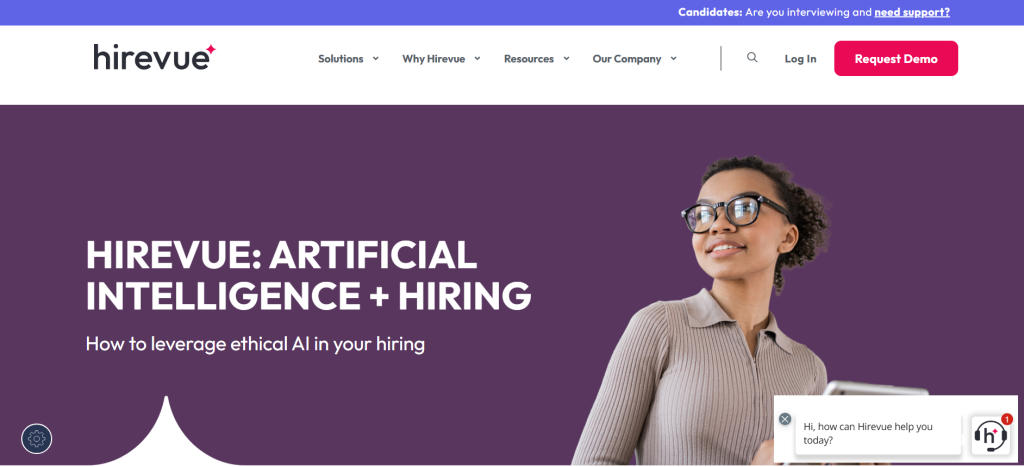
HireVue is a smart video interview platform that uses AI to analyze pre-recorded candidate responses. It helps recruiters assess communication skills, thinking ability, and job fit more efficiently. The platform works well with various applicant tracking systems, making the process seamless. Its structured format and instant feedback help ensure consistent evaluations. HireVue is a strong choice for organizations handling large-scale hiring.
Unique Feature: Adaptive question sets that adjust based on candidate responses.
Spark Hire
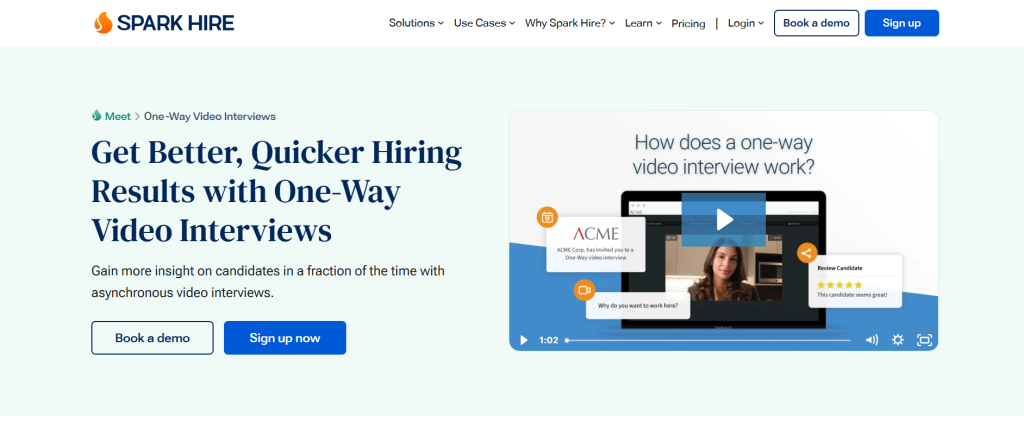
Spark Hire offers a quick-to-launch virtual interview solution with a focus on simplicity. It lets recruiters create custom questions and easily review responses. The platform is flexible for teams of any size and supports branded interviews to reflect the company’s identity. Its clean interface and strong support make it easy for new users to get started.
Unique Feature: Live panel feedback collection during video review.
VidCruiter
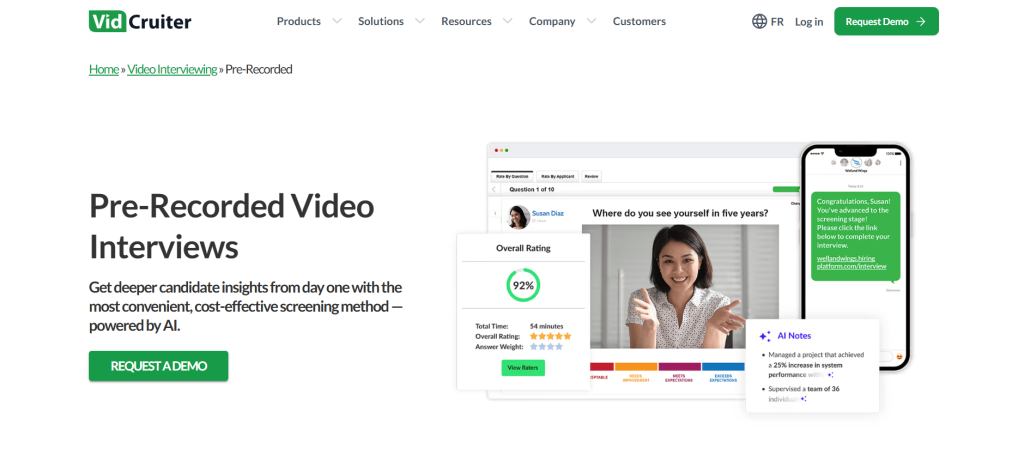
VidCruiter provides a secure and customizable video interview solution tailored to company workflows. It supports both one way and live panel interviews, offering flexibility in how teams assess candidates. The platform includes strong compliance controls, real time monitoring, and detailed reporting to help recruiters make informed decisions with confidence.
Unique Feature: Built-in compliance tracking for regulatory requirements.
Hireflix
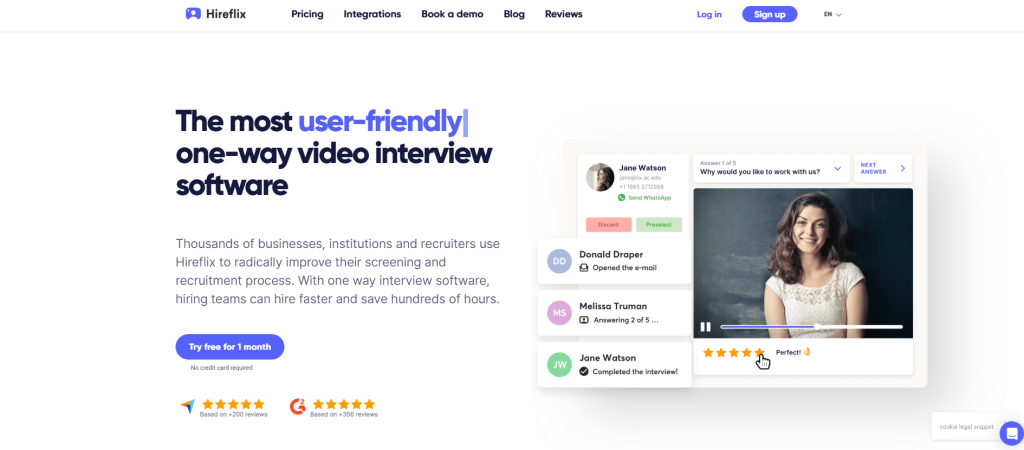
Hireflix is built for volume hiring, offering unlimited one-way virtual interviews on a simple interface. It focuses on ease of use for both candidates and recruiters, while still allowing for branded questions and easy review. Its pricing model and minimal setup make it a popular option for teams looking to scale fast without complexity.
Unique Feature: Unlimited interview submissions for a flat fee.
Conclusion
Throughout this blog, we have seen how one-way video interviews are transforming the way companies approach hiring. They bring structure, fairness, and flexibility into the pre-screening process, enabling recruiters to review candidate responses at their convenience, save time, and focus on identifying the best fit for the role. For candidates, asynchronous interviews reduce the stress of scheduling conflicts, provide flexibility to complete interviews at their preferred time, and offer a comfortable environment to showcase their skills.
The integration of AI-driven tools and digital platforms like InCruiter further elevates this process. By combining automated evaluation, structured question sets, and real-time analysis, recruiters can make informed decisions with confidence and efficiency. This shift from traditional, resource-heavy interview methods to intelligent, streamlined workflows represents the future of recruitment. Companies embracing this evolution are not just saving time and costs; they are also improving candidate experience and ensuring better hiring outcomes.
It’s time to move beyond outdated processes and step into a world where technology supports smarter, fairer, and more scalable hiring. Discover how InCruiter’s one-way video interviews can help you hire better, faster, and smarter today.
Frequently Asked Questions
What is the difference between one-way and two-way video interview?
A one-way video interview is conducted entirely by AI, allowing candidates to complete their interview at any time that suits them, whether early morning or late at night. The platform remains available 24/7, eliminating the need for human interviewer participation and reducing workload for the in-house hiring team. Candidates record answers to pre-set questions, and the Conversational AI Interviewer evaluates their responses for in-depth insight.
In contrast, a two-way video interview is a live interaction where the candidate and the human interviewer connect through video interview software. Here, the recruiter asks questions directly, and candidates respond or solve coding challenges in real time, with human oversight throughout.
What is a short one-way video interview?
A short one-way video interview is a streamlined version of a standard one-way interview, typically consisting of a few targeted questions. Instead of a full-length interview with many questions, this format focuses on quick responses to key areas, such as communication skills, role-specific knowledge, or general motivation. Candidates usually have limited time for each response, often under 2 minutes per question.
This format allows recruiters to screen many candidates more efficiently and quickly identify those with the necessary skills or qualities for the next stage. It is a popular approach for high-volume roles or early-stage screening.
What are common one-way video interview questions?
Common one-way interview example questions typically cover a mix of personal, behavioral, and role-specific areas.
Examples include:
> Tell us about yourself,
> Why are you interested in this role?
> Describe a time when you handled a challenging situation at work.
> How do you approach problem-solving?
> Explain a recent project you worked on.
> Describe your process for debugging a complex issue.”
These questions are designed to evaluate communication clarity, decision-making skills, technical knowledge, and overall cultural fit. Each candidate faces the same set of questions, ensuring fairness and consistency in assessment.
Are one-way video interviews assessed by AI?
Yes, one-way video interviews are assessed by AI during the initial screening stages. AI systems can evaluate candidate responses based on language use, tone, confidence, facial expressions, and more. These tools are programmed to detect patterns that align with job requirements, enabling standardized and objective assessments. However, human review is often used alongside AI to ensure well-rounded evaluations.
AI helps recruiters by saving time, reducing bias, and generating detailed reports, but humans typically make final hiring decisions. This blend of technology and human judgment makes the process efficient while maintaining quality.






